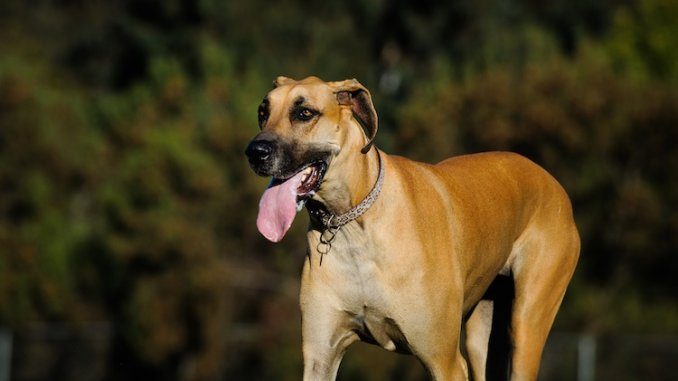
The gentle giant of the canine universe, Great Danes are known for being one of the biggest dog breeds in the world.
They are loyal, playful, a tad goofy, and extremely well-natured towards children, but what about their appearance?
At just three months old, this dog already weighs a massive 30 to 45 lb!
You may have seen the stereotypical Great Dane colors, the most popular of which is fawn.
But, did you know, there is a total of seven different color variations; all of which are accepted in the American Kennel Club’s breed standard.
In this article, we will guide you through every color, where they come from, interesting facts, and how to spot one!
TABLE OF CONTENTS
1. Fawn Great Dane
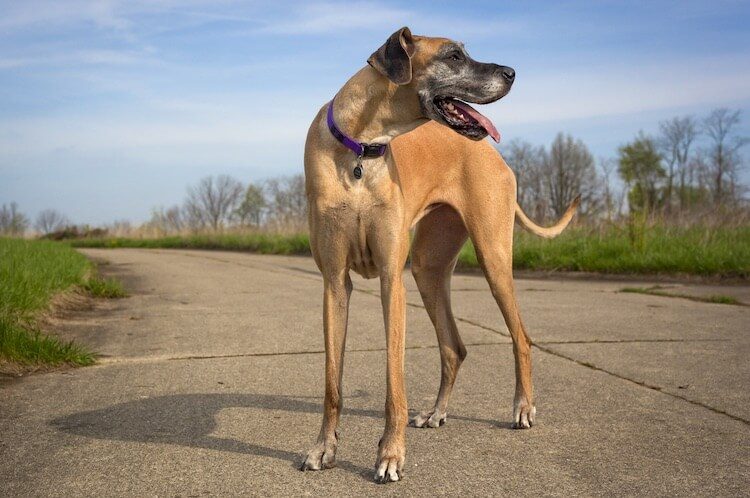
From Adobe Stock
The fawn-colored Great Dane is a classic, especially if you’ve seen Marmaduke or if you are a Scooby-Doo fan!
Fawn is the dominant color over this puppy’s body; while they have a black or dark mask over their ears moving down to their nose.
The fawn color must be emphasized in all areas of the dog.
If the dog has dark or white markings around its body or paws, then this is a considered to be a fault and is not an officially recognized color.
Unfortunately, this means that Scooby Doo’s black markings are a wee bit of a mishap!
Did you know?
Some Great Dane puppies can be born unmasked? So not all of these tiny pooches will have a dark masked look. This is actually all to do with their parents’ genetics and their “mask” gene.
Fawn Puppies
Although the fawn coat is one of the most popular Great Dane colors, the coloring is actually due to a recessive gene.
Therefore, both parents must carry the “fawn” gene in order to produce a fawn puppy.
2. Brindle Great Dane
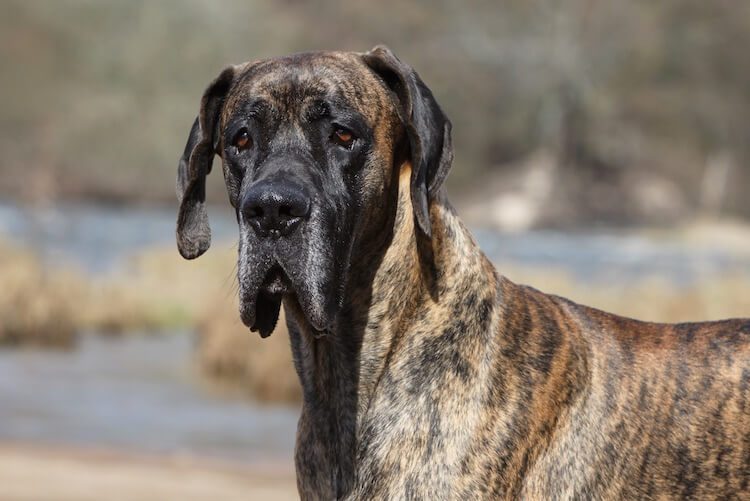
From Adobe Stock
The brindle Great Dane is definitely a blurred mismatched coat of a beautiful dog!
A brindle coat can be described as an assortment of patterns of stripes, with all sorts of colors including:
- Black and Red
- Fawn and Black
- Light and Dark Gray
- Blue
Brindle coats usually have a base coat settled beneath their pattern, the base coat is typically the classic fawn of a Great Dane.
However, sometimes this base coat might be a lighter or darker fawn or a red coloration.
Again, just like with fawn-colored dogs, any white mark discrepancies on the chest and toes are not desirable.
Brindle Puppies
Brindle dogs are bred by the mating of two brindle-coated Great Danes.
However, even two Brindle-coated parents may give birth to Fawn-coated puppies.
Additionally, the base color amongst puppies may differ with some puppies having a darker or lighter fawn; the prominence of coats cannot be predicted.
What About Blue Brindle?
As we discussed above, the Great Dane’s brindle may even be a shade of blue.
This occurs due to a recessive “blue gene” which must be carried by both parents. Unfortunately, although unique, this is a serious fault and it is not recognized by the American Kennel Club.
3. Blue Great Dane
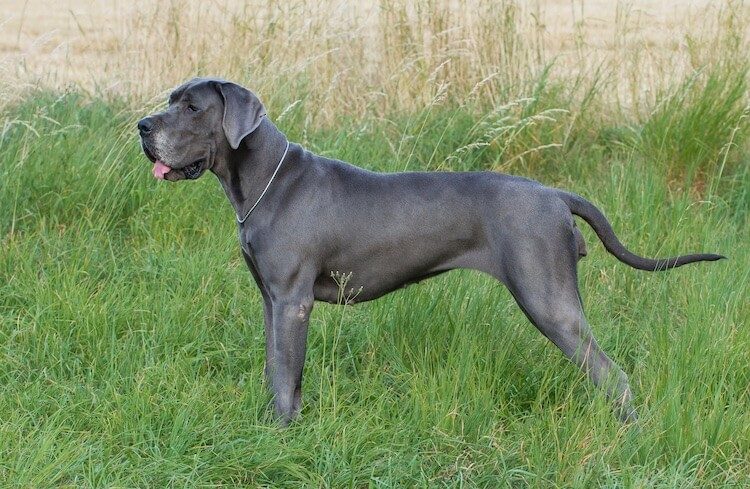
From Adobe Stock
Blue Danes are sometimes known by the name “blue steel” because of their distinctive coloration.
This coat is magnificent and can range in all sorts of shades, whether darker or lighter. However, the true most popular shade is steel blue.
The steel blue fur must be dominant throughout your dog’s body, white or darkened markings are again a fault.
Given their size and unique color, the blue Great Dane is a very eye-catching breed, increasing in popularity behind the fawn coloration.
Blue Puppies
Like most Great Dane colors in this list, the blue is bred by the mating of two blue purebred parents as they will carry the blue gene.
The blue color comes from a recessive gene and therefore both parents must carry the gene to guarantee there will be blue pooches amongst the litter.
4. Black Great Dane
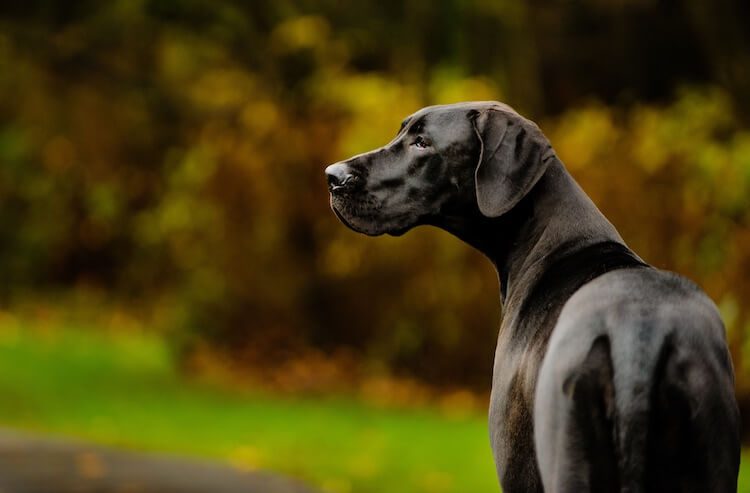
The black Great Dane is a beautiful dog and this coat coloration does extraordinarily well in dog shows.
A black coloration allows sunlight to emphasize their muscular stature perfectly.
The black Great Dane is therefore bred for showing purposes. Although, they are often used as family pets or companion puppies too.
In order for a black Dane to be recognized by the American Kennel Club, no white markings can be visible on their chest or legs (i.e. they must be completely jet black).
Black Puppies
Again, this is all down to genetics.
As with many colorations, black is a recessive color (carried by the “K locus” gene) and therefore both parents must carry the black gene in order to produce black puppies.
5. Harlequin Great Dane
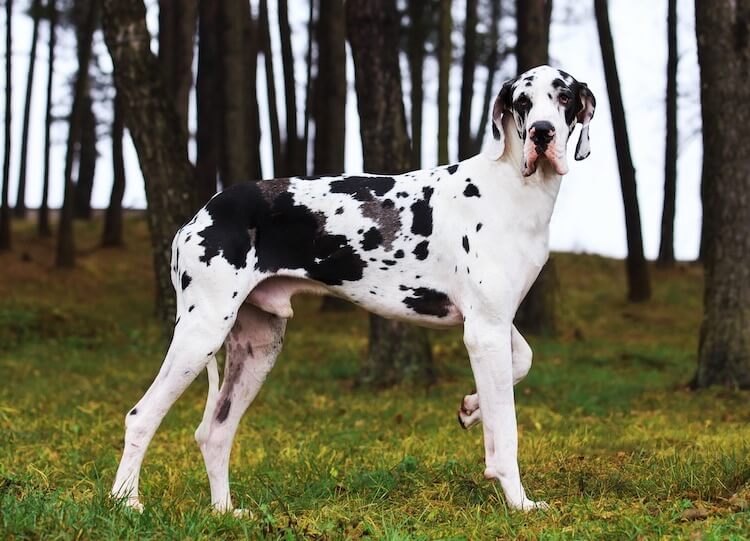
The harlequin coat coloration consists of a pure white base coat with black markings splotched in an irregular pattern throughout their body.
This coat coloration is a little tricky, and has multiple breed standards which can easily make the coat a fault (e.g. splotch size and position):
- Their neck area must be spotless and completely pure white
- Any black marks should not be too large as to dominant any section of their gigantic bodies
These faults make it much harder to achieve an officially recognized harlequin-coated puppy!
Harlequin Puppies
The harlequin coat coloration is down to genetics, however, these genetics are also linked to health issues.
A major health issue being congenital deafness.
This is significantly linked to the “white” gene in dogs. As the harlequin breed has a dominant white color (e.g. their base color) there is a chance this health issue can be inherited.
The Harlequin gene is also known to be homozygous embryonic lethal.
This means that if a puppy inherits two of these genes they are often miscarried as an embryo.
Therefore, instead of simply breeding harlequin males with harlequin females. Breeders tend to breed harlequin x mantle coated dogs.
This helps to dilute any associated health issues which may occur in the litters, whilst still achieving the harlequin coat.
6. Mantle Great Dane
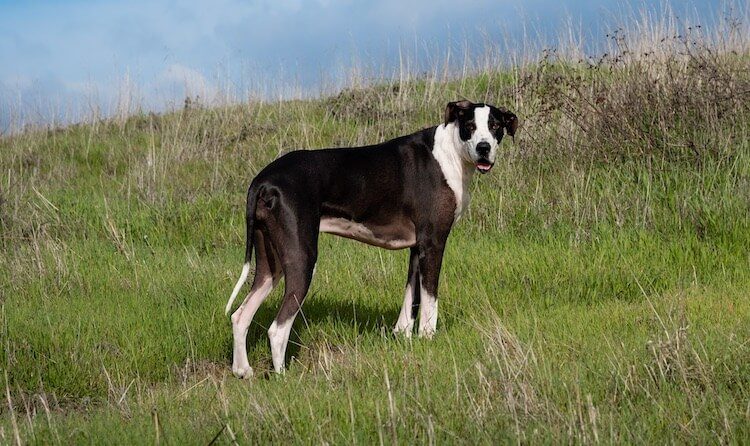
From Adobe Stock
The mantle-colored Great Dane consists of two colors: black and white.
Black is the dominant coloration in the coat (i.e. the opposite of the Harlequin coat). With the white color being limited to specific areas of their body.
Black coloration should be found on the majority of the body.
The white coloration should appear on their muzzle, around their collar, chest, and both their forelegs and hind legs.
Here, a white mismarking may be accepted by the breed standard and it is known as a break in their white collar.
Mantle Puppies
Mantle Great Danes were once known as “Boston Great Danes” due to their coat similarities with the Boston terrier breed.
This was during the 1990s, so official recognition of the “mantle” coat coloring has only existed for the past two decades.
7. Merle Great Dane
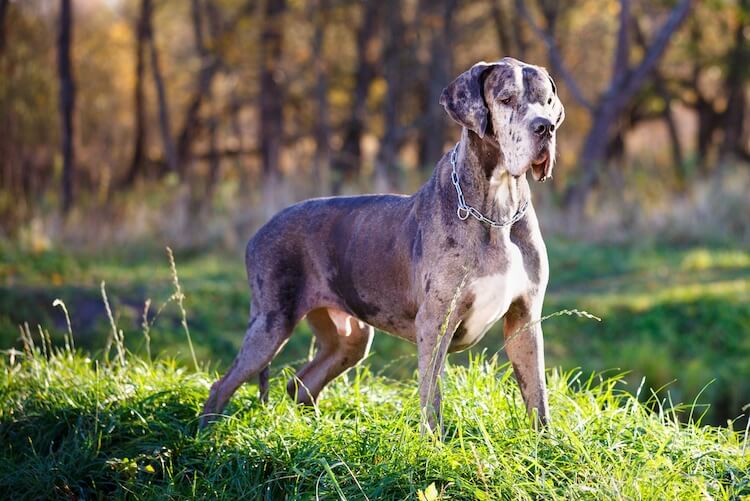
The merle coloration was only recognized by the American Kennel Club in 2018 and is the last on our list of Great Dane colors.
This coat is similar in appearance to the harlequin color, and because of this, some confusion does occur:
- The base coat of the merle is a darker color (normally gray) instead of a white
- The spotting around the body is not limited to just black coloration. Instead, both black and white spots can be seen
Any merle x harlequin coat variation is known to be a serious fault.
Merle Puppies
We can thank genetics for this new coat variation; specifically the “M(Silv)” gene.
The Merle Gene is also a dominant gene, in contrast to many other colors which are recessive.
Because of this, breeders should not breed a merle x merle combination, as a double merle coat can lead to serious health issues.
In fact, 2.7% of dogs carrying this gene have been prone to congenital deafness in at least one ear.
Blindness and other eye defects are also a factor in the merle gene coloration, this is because the merle gene is also associated with eye color too.
Aside from the health issues, the merle coat color is absolutely beautiful and it is no surprise that the American Kennel Club recently added this to the breeds standard.
Just make sure you research a good breeder to reduce the chance of incorrect breeding.
Summary
| Fawn | Light tan or yellow to dark tan or gold with a black mask | Yes |
| Brindle | Brown base color with black or dark stripe-like patterns | Yes |
| Blue | Steel-blue like color with no white markings permitted | Yes |
| Black | Jet black with no white markings permitted | Yes |
| Harlequin | White with patches of black | Yes |
| Mantle | Black dominant color with white markings on the muzzle, chest, and neck | Yes |
| Merle | Patches of a different color (i.e. different greys, whites, and blacks) | No |
As you may have noticed, there is a lot more variation to their coat than the common fawn.There you have it, all seven of the different Great Dane colors.
Each color is beautiful and unique in its own way, while others (e.g. merle) carry some stigma with health concerns.
Whilst color may impact their health, it plays no role in behavioral or temperamental differences! Making every canine as loyal and goofy as the other.
What’s your favorite color? Please let us know below!

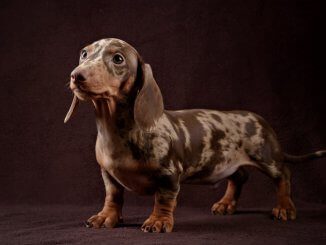
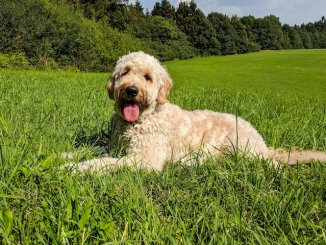

I own a lilac harlequin Great Dane. I have also shown AKC on and off for over 5 decades. I know my dog cannot be shown in conformation but she still participates in other events.
I owned a Brindle Great Dane. Why isn’t the box marked yes???
They are certainly accepted by the AKC.